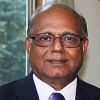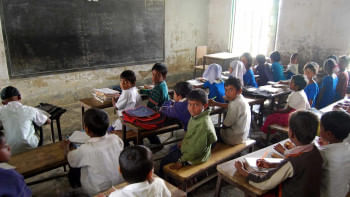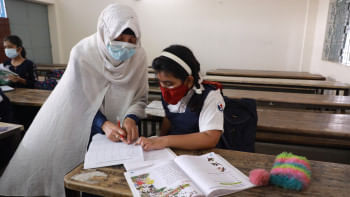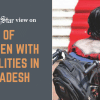Can the latest school census data help curb dropout?

The Annual Primary School Census (APSC) 2023 report published by the Directorate of Primary Education provides an account of children attending and completing primary education and of institutions at this level. It says little about what students take from primary schools by way of knowledge, skills and values that can make a difference for the next stages of their education and life.
Rumana Ali MP, state minister of primary and mass education, said in a preface to the recently published report that insights from it would help undertake "targeted actions and strategic measures" to enhance the "educational journey and achievements of every Bangladeshi child." Shah Rezwan Hayat, director-general of primary education, added that the insights and recommendations of the report would serve as a "fundamental platform for fostering informed discussions and collaborative actions."
What are the insights offered by the report, and what are the recommendations? There are two pieces of advice: about improving the quality of data for the report itself, and about improving primary education outcomes. Let's look briefly at them.
As the report notes, a post-enumeration quality check of the APSC data, undertaken by the Bangladesh Bureau of Educational Information and Statistics (BANBEIS), showed that there was an estimated error of 3.44 percent in coverage of institutions in the school census. This means that over 4,000 primary-level institutions may have been missed out by the census.
More importantly, the quality check also showed that there was a measurement discrepancy of five percent (plus or minus) between the school census data and the post-enumeration check. The report claims that a probability of five percent error was "negligible" and the results "seemed to be good and acceptable" for policy measures. Actually, the under-coverage of institutions and the error margin do cast doubt on the validity of the findings as the basis for corrective actions and policy measures.
For example, the drop in student enrolment by about 8.5 lakh from the previous year is under 0.5 percent of total enrolment, well within the five percent plus or minus margin. It is also noted in the report that accuracy regarding the data from kindergartens and private schools has been challenging and no data has been collected from Qawmi madrasas. These institutions together are likely to be enrolling one-third of the primary-level students. The declining birth rate in recent years also reduces the number of children seeking primary education enrolment.
The report mentions that better methodology and tools such as the Integrated Primary Education Information Management System (IPEIMS) may have helped to correct past data biases, and that the improved tools as well as verification through post-enumeration check should be applied to maintain data quality. These are reasonable advice and deserve serious attention to come out with reliable educational input data regarding students, teachers, and institutions.
At the same time, it is necessary to remember that by its very nature and intended purpose, the APSC lacks outcome data regarding how much and what students learn. The annual school census is far from a comprehensive and holistic picture of primary education.
So, should we not be concerned about dropout and exclusion of children from school? Yes, we should, and the APSC points to problems but does not provide a full and reliable picture. We should also ask what light the school census throws on improving primary-level performance and student-learning outcomes.
Drawing conclusions from the collected input data about institutions, students, and teachers, the report suggests a number of action steps. These are based more on general discourse on education equity, quality and inclusion issues, rather than extracted specifically from the census findings. They include: targeted interventions to engage all primary school-going children more effectively in education; expanding access to pre-primary education for equitable participation across genders; strengthening special needs education with improved resources and teacher training; community engagement; and professional development opportunities for teachers.
These are sound general advice with which few would disagree. But how can these be acted upon with practical strategies, plans, and actions? Along with the input data from the APSC (which needs to be more inclusive and accurate), we also need to have reliable and inclusive outcome information in the form of learning achievements of students, derived from practical learning assessment tools.
In fact, the National Student Assessment exercise that takes place periodically (roughly every two years) since 2011 can be seen as such an instrument. The last NSA report for 2022 was released in June 2023. It revealed that almost half of the students in Classes 3 and 5 had below grade-level competencies in Bangla, and only a third of the students achieved expected grade-level competencies in mathematics. These were results largely similar to those seen from the NSA in 2017 and earlier rounds. In other words, more than half of children who attend and complete primary grades do not achieve the expected basic skills in literacy and numeracy, and the situation has not improved over the years. By contrast, the primary school completion examination (now discontinued) and Class 5 annual examination routinely showed pass rates of over 95 percent.
It has been noticed that there is a greater involvement of education officials and external development partners, much fanfare and public discussion associated with the annual APSC reports than with the less regular NSA reports. The policymakers seem to be more interested in inputs than outcomes, and there is an antipathy towards connecting the two.
Periodic assessment of learning and annual reporting on inputs have not been undertaken systematically at the secondary level, which is under the jurisdiction of a different ministry. But available evidence suggests that learning outcomes at secondary level could not be any better. A reason, it may be plausibly argued, is that poor foundational learning of children at primary level has knock-on effects on later stages of education.
A pragmatic, relatively simple and easily implementable assessment of learning known as Annual State of Education Report (ASER) has been pioneered in India by the NGO Pratham, and replicated in Pakistan, Nepal and a number of African countries. An NSA or ASER model, with adaptation as necessary, developed and applied systematically to school education can be a way to better understand the interplay of learning inputs and learning results. Thus, policy and action can be better guided and implemented to ensure basic education for all children with equity, quality, and inclusion.
As argued by this writer and others, taking the sustainable development goal for education (SDG4) and the education imperatives for scaling the heights of a higher-middle-income country status seriously means that basic K-12 school education must be ensured for all children.
We cannot continue to keep primary and secondary education in discrete boxes and try to plan and manage these separately just because the education bureaucracy has been set up in a certain way. Denial of basic education to more than half of the children should not continue.
Dr Manzoor Ahmed is professor emeritus at BRAC University, chair of Bangladesh ECD Network (BEN), adviser to the Campaign for Popular Education (CAMPE), and associate editor of the International Journal of Educational Development. Views expressed in this article are the author's own.
Views expressed in this article are the author's own.
Follow The Daily Star Opinion on Facebook for the latest opinions, commentaries and analyses by experts and professionals. To contribute your article or letter to The Daily Star Opinion, see our guidelines for submission.

 For all latest news, follow The Daily Star's Google News channel.
For all latest news, follow The Daily Star's Google News channel. 






Comments